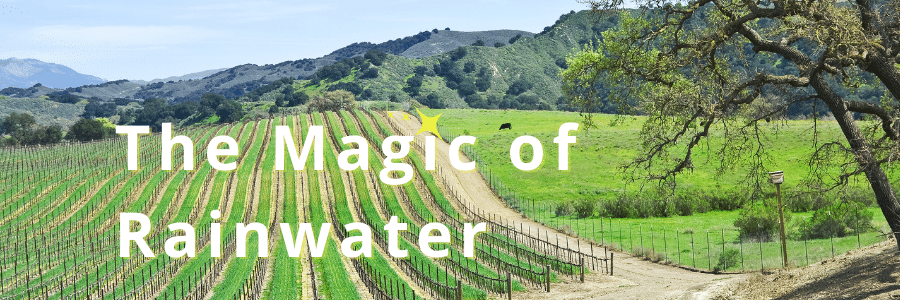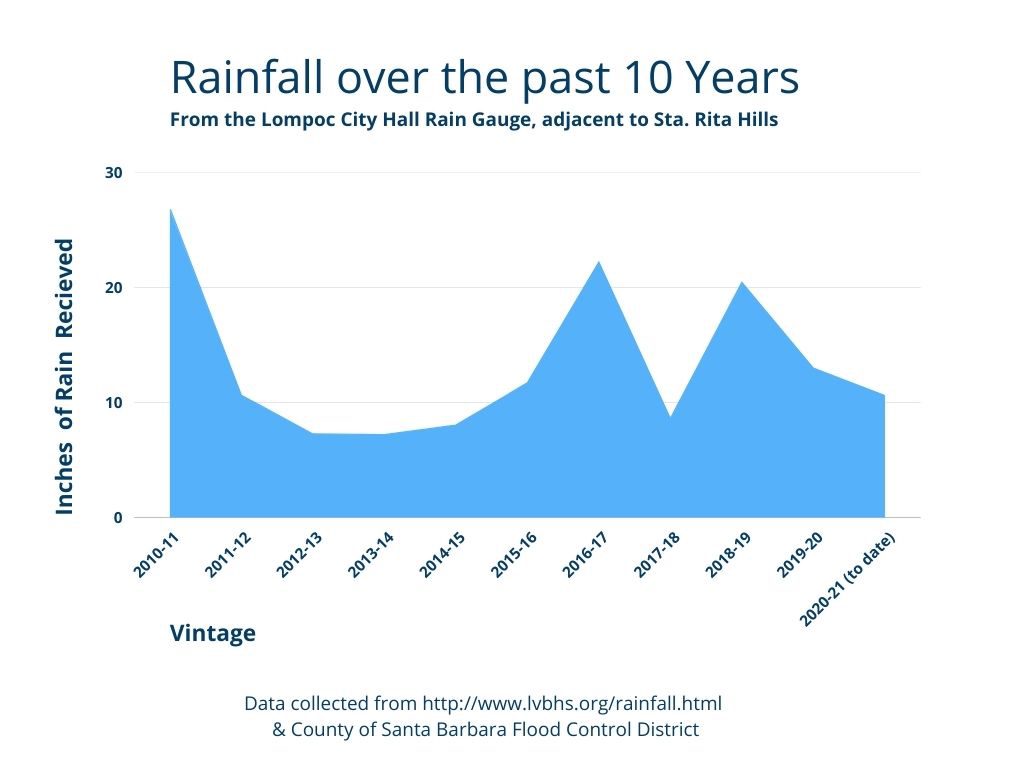No products in the cart.
The Magic of Rainwater
Folks in the wine business in Santa Barbara County are breathing a little easier since the rains we received in February and early March. For growers especially, every winter downpour slightly lessens a drought anxiety that has become all-too-familiar.
Some wine regions in the world are dry-farmed as a rule to preserve terroir and character (think Burgundy, Bordeaux, Barolo). But here in the central coast of California we get most of our rain in the winter, often receiving zero to 2 inches of rain during spring fruit set and none at all during summer, so irrigating at least part of the year is a necessity for most vineyards in our region.
This year rainfall totals near the Sta. Rita Hills (see the graph below) are still relatively below average, but the recent rains are enough to get the cover crops at vineyards sprouting and the California poppies popping by our roads.
Why is rainwater so important?
We intuitively know that rainwater is good for plant growth and that vines look greener and healthier in our region after a winter of heavy rains, but what are the reasons for this? What is actually going on out there in the vineyard? Here are some fun facts about the effect of rainwater on soils and vines:>
- When we have consecutive vintages with low rainfall, sodium and other salts that damage soil and inhibit plant growth can build up in the vineyard soil profile. In healthy soil, soil particles clump together in beneficial aggregates. When concentrations of sodium are high, these aggregates are dispersed creating a cracked soil surface and damaged soil structure. Additionally, sodium concentrated in the soil around root structures inhibit plants from evenly taking up moisture. During years with heavier rains, rain water leaches these accumulated salts down beyond the root zone. When these salts are flushed through the soil after several years of accumulation, plants respond with bold growth.
- Also, rainwater falls uniformly across a vineyard dispersing the leaching affect evenly, so even the furthest reaches of a plant’s root zone will be bathed and cleansed of salt.
- As rain falls, it captures Carbon dioxide and combines with other minerals in the atmosphere turning the rainwater pH acidic. When this acidic rainwater reaches the soil (not to be confused with acid rain), it helps to release micronutrients such as zinc, manganese, copper and iron that are essential to plant growth but are mostly locked up in the soil, which typically registers a neutral to alkaline pH.
- Rainwater contains more oxygen than irrigation water. Oxygenated water allows roots to uptake more H2O and micronutrients into the plant resulting in more health and vigor in the vine.
- Rainwater replenishes the groundwater reserves that are tapped by the deeper reaching roots of older vines and and also tapped by the farmer’s wells to irrigate vines through the summer months.
The above is just a short list of why it’s beneficial for our vineyards to get a good soaking from the sky every now and then. Not only does rainwater refresh and renew the soil, it makes the hills verdant green and full of wildflowers. Springtime is a gorgeous time to visit the Santa Ynez Valley! We invite you to come taste wine on our patio in Los Olivos and see for yourself.






